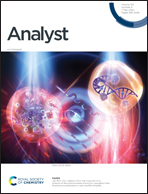Paper-based platforms with coulometric readout for ascorbic acid determination in fruit juices†
Abstract
There is growing interest in the development of simple, fast, sustainable and low-cost analytical methodologies on paper-based platforms. However, sensitive detection strategies that fit properly with these devices are still required. In this work, a calibration-free method is proposed for analytical determinations performed on paper-based electrochemical devices, in this case, for ascorbic acid. Carbon ink is deposited on a hydrophilic working area of the paper delimited with a hydrophobic wax. This maskless procedure is fast and cuts down ink waste. The connection of this working electrode to the potentiostat is provided by reusable gold-plated connector headers that provide also the reference and counter electrodes. The thickness of the paper substrate defines the electrochemical cell and confines a sample volume, ideal for thin-layer coulometry. Controlled-potential coulometry is performed applying a potential of +0.6 V for 50 s. The charge is calculated by measuring the area under the fast chronoamperogram and the concentration is determined following Faraday's law (known number of transferred electrons). This methodology was applied to the determination of ascorbic acid, with a limit of detection of 40 μM. Its concentration in commercial fruit juices can be directly determined in diluted samples. The absence of matrix effects is observed by comparing the results obtained before and after enzymatic reaction of the sample with cucumber ascorbate oxidase. Good accuracy and precision makes this method suitable for quality control of ascorbic acid in commercial juices. Underexploited coulometric readout can be applied as a fast (calibration-free) and low-cost (standards not required) transduction principle for the newly developed paper devices.



 Please wait while we load your content...
Please wait while we load your content...